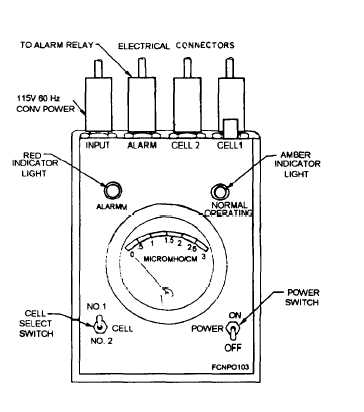correct flow rate through the flowmeter. The high of a
flow rate can damage the cartridges. If the flow rate
cannot be increased to the proper rate with the inlet
supply valve fully open, you should check to ensure that
the outlet valve is fully open. The submicron filter is
used to remove small particles from the coolant flow
having a size greater than 0.5 micron. If the filter
becomes clogged, it also reduces the flow of coolant.
This necessitates a change of the filter cartridge or filter
sheet (membrane). To change the filter, the
demineralize valves must be properly positioned.
If the filter cartridge or membrane continually
becomes clogged (about one-half hour or less after
replacement), the usual cause in the distilled water
system is the presence of bacteriological impurities,
Bacteriological impurities introduced into the
secondary liquid cooling system using distilled water
may exist in the demineralize cartridges and/or the
whole secondary cooling system. If the bacteriological
impurities are in the whole secondary cooling system,
the growth rate in a warm water environment could be
of a magnitude that exceeds the capability of the
demineralize. You will have to determine the source
and magnitude of contamination. However, it should be
noted that bacteriological contamination in a secondary
cooling system that uses distilled water and ethylene
glycol is highly improbable.
Improper handling or storage of the cartridges could
cause the cartridge to be a source of contamination. You
should always store the cartridges in a cool, dry area.
Exposure to heat hastens the growth of any biological
contaminates that may have entered the cartridges. You
will encounter three different types of cartridges. The
first cartridge is the organic removal cartridge. It
contains granulated activated charcoal (carbon) that
removes large organic molecules and chlorine by
adsorption. It is always installed in the first exchanger
(if required) to prevent organic molecules from fouling
the remaining cartridges. The second cartridge is the
oxygen removal cartridge. It is composed of anion
resins that remove oxygen from the water by ion
exchange of sulfite ions to sulfate ions. By conducting
a standard oxygen test (or if the cooling system has an
oxygen analyzer installed), the quality of the outlet
water from the demineralize can be tested for oxygen
content so that you will know when to replace an oxygen
cartridge. When the oxygen cartridge is near
exhaustion, it will have a urine odor, which is given off
by the sulfate. The third cartridge is the mixed-bed
cartridge. It is filled with cation (positive charge) and
anion (negative charge) resins, which remove solids,
dissolved metals, and carbon dioxide. The charged
resins exchange ions with the contaminates, thereby
removing them and leaving pure deionized coolant. You
should replace the mixed-bed cartridge when the purity
meter indicates a low outlet purity.
As indicated in figures 1-25 and 1-26, two
conductivity cells monitor the coolant through the
demineralize. The first cell measures the purity of the
coolant as it enters the demineralize. The second purity
cell is used to measure the purity of the coolant as it
leaves the demineralize. The conductivity cell consists
of two electrodes immersed in the coolant flow path.
The electrodes measure the conductivity of the coolant,
which varies with the amount of ionized salts dissolved
init. If the impurity content increases in the coolant, the
purity meter indicates higher conductance.
On some purity meters, the purity of the coolant is
displayed as resistivity. In this type of meter, an increase
in the impurity of the coolant causes the meter to
indicate a low resistivity. Conductance is the reciprocal
of resistance, and is measured in micromhos/cm.
Resistivity is measured in megohms/cm. You can
convert from conductivity to resistivity by taking the
reciprocal of conductivity. Similarly, the reciprocal of
resistivity is equal to the conductivity. A comparison of
both ways of measuring the purity of the coolant is
Figure 1-26.-Purity meter.
1-21


